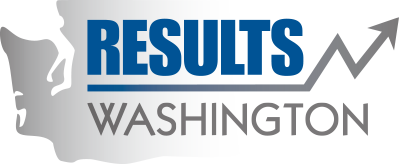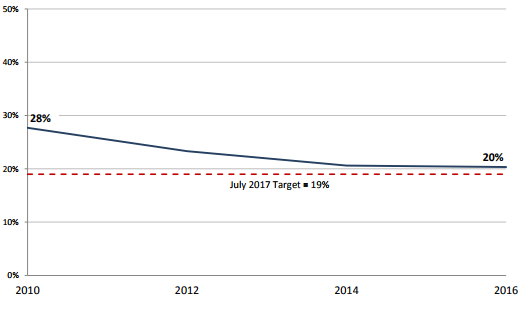Archived: 10th graders who report drinking alcohol in the last 30 days
Underage drinking has both negative consequences for the individual and high socioeconomic costs to society. Preventing or delaying the onset of underage alcohol use is associated with positive outcomes, such as improved school performance, reduced youth delinquency and positive mental health.
The age of first use and frequency of use of alcohol is linked to adult alcohol dependence. Reducing alcohol use among 14-18 year old's will likely result in future medical, criminal justice, and productivity cost savings.
We monitor 10th grade alcohol use at the state and local level to understand the implications of policy changes on adolescent alcohol use over time. The data also provide an indication of statewide prevention strategy effectiveness, and help to determine the need for additional investments as statewide trends change and local high need communities are identified.
Alcohol use by 10th graders has shown a progressive decline since 1990, declining nearly 24 percentage points between 1990 (44%) and 2016 (20%). The latest survey results show that Washington is below the national average of 24.8%, but above the newly established target of 19% (by 2017).
A 1% net reduction was realized from 2014 (20.6%) to 2016 (20.3%). Underage drinking has been going down across the country; the 10th grade trend in Washington is better than the national average of 23.5%.
With perception of harm data we want to see an upward trend. The 2016 Healthy Youth Survey (HYS) data demonstrate that youth in Washington report they understand the risks and harms involved with drinking once or twice a day. Washington data is better than the national data in this regard.
Despite the reduction in its use, alcohol still remains as the number one drug of choice when youth choose to use substances.
During the two years following the implementation of alcohol privatization in Washington State (as a result of the passage of Initiative 1183 in 2011), we observed (Source: Julia Dilley, 2016):
- No measurable, sustained change in alcohol drinking patterns among the general population of youth (e.g., "any current drinking" or reaching a threshold of "heavy" or "binge drinking").
However, independent measures of alcohol-related harms did show change (Source: Julia Dilley, 2016):
- Increases in single vehicle nighttime crashes (a proxy for alcohol-impaired driving), especially among drivers under age 21.
- Increases in alcohol-related emergency room visits, especially among people under age 21.
- Increases in alcohol-related crime, especially shoplifting.
- Increases in public-paid alcohol dependence treatment, especially among youth and people who had been previously admitted for dependence treatment.
Since 1998, the Washington State Department of Social and Health Services, Behavioral Health Administration, Division of Behavioral Health and Recovery (DBHR), has administered federal Enforcing Underage Drinking Laws (EUDL) funding for community and statewide programs. As part of that effort, the Washington State Coalition to Reduce Underage Drinking support youth influencers (such as parents, caregivers, coaches, religious leaders, educators, other youth) by:
- Expanding and enhancing efforts and website to promote discussions about alcohol. (Start Talking Now).
- Assisting communities in continuing to reduce underage drinking locally. (Let’s Draw the Line).
- Developing and distributing tool kits for the implementation of social host ordinances in Washington communities.
Other work includes:
- Sustain Tribal prevention programs and the Community Prevention and Wellness Initiative, including the Prevention/Intervention Program.
- Provide public education and awareness efforts for middle school aged youth and their parents.
- Develop key prevention messages with partners for statewide distribution.
- Support community-based organizations, regional and statewide partners in distributing messaging.
- Develop a prevention marketing campaign with state partners.
- Implement and evaluate a prevention marketing campaign.
The Start Talking Now website provides information for parents and community members about the risks of underage drinking and proven ways we can help more teens.
For information on the link between age of onset and alcohol dependence, refer to The July 2006 JAMA Pediatrics article Age at Drinking Onset and Alcohol Dependence Age at Onset, Duration, and Severity available online. Age at Drinking Onset and Alcohol Dependence

